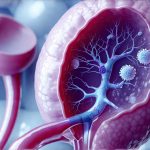Interstitial Cystitis (IC), also known as Bladder Pain Syndrome (BPS), is a chronic condition causing bladder pain, urinary frequency, and urgency. It’s a frustrating illness, often difficult to diagnose, and even more challenging to manage. Unlike many other conditions, there isn’t a single “cure” for IC, making the search for relief – and ideally, prevention – incredibly important to those who live with it daily. The complexities of the condition stem from its poorly understood etiology; researchers believe genetics, autoimmune responses, nerve damage, and even infections may play contributing roles, but pinpointing exact causes remains elusive. This makes developing truly preventive drugs a significant hurdle, as understanding what exactly needs preventing is still under investigation.
Living with IC profoundly impacts quality of life. The constant discomfort can disrupt sleep, interfere with work and social activities, and lead to emotional distress like anxiety and depression. While current treatments focus largely on managing symptoms – things like dietary changes, physical therapy, medications to reduce bladder spasms or pain, and in some cases, more invasive interventions – the prospect of proactively reducing someone’s risk of developing IC is a highly sought-after goal. This article will explore the current understanding of potential preventive strategies and drugs related to interstitial cystitis, acknowledging the limitations of existing research and highlighting areas where future advancements may lead to better outcomes.
Current Approaches & Limitations in Prevention
The concept of “preventing” IC is complex because we don’t fully understand its origins. This makes traditional preventative medicine – like a vaccine or a single targeted intervention – difficult to achieve. Currently, most ‘preventative’ strategies are aimed at mitigating factors that might contribute to the development or exacerbation of symptoms in susceptible individuals. These often fall into lifestyle modifications and addressing related health conditions. For example, reducing stress levels is frequently recommended as chronic stress can potentially worsen bladder sensitivity. Similarly, dietary changes to eliminate potential irritants – such as caffeine, alcohol, artificial sweeteners, and acidic foods – are common recommendations, although the evidence supporting these dietary restrictions is largely anecdotal for prevention, more focused on symptom management once IC has developed.
A key challenge lies in identifying individuals at risk before symptoms appear. There aren’t reliable biomarkers or genetic markers that predict who will develop IC. This means preventative efforts are often broad-based and rely on general health recommendations rather than targeted interventions. Some research suggests a link between early life infections (like urinary tract infections) and the subsequent development of IC, but establishing a definitive causal relationship has proven difficult. It’s important to distinguish between preventing initial UTIs (which are preventable with good hygiene and prompt treatment) and preventing the progression to IC as a consequence of those UTIs. The latter is where preventative strategies are currently lacking.
Another limiting factor is that many individuals live with IC for years before diagnosis, meaning any potential preventative measures would ideally need to be implemented long before symptoms become noticeable. This presents a practical difficulty in studying the effectiveness of interventions designed to prevent the condition’s onset. Most studies focus on managing existing IC rather than assessing true prevention strategies. The research landscape is further complicated by the heterogeneous nature of the disease itself; what works for one person may not work for another, making it difficult to generalize findings and develop universal preventative protocols.
Exploring Potential Drug Candidates
While a dedicated “preventive drug” doesn’t currently exist for IC, several medications used to manage symptoms are being investigated for their potential role in slowing the disease progression or even preventing its development in at-risk individuals. Pentosan polysulfate sodium (Elmiron), originally developed as an anticoagulant, has been studied extensively and is sometimes used off-label with the hope of restoring bladder lining integrity. Although initially promising, recent concerns about retinal damage associated with long-term Elmiron use have significantly dampened enthusiasm for its preventative potential. Heparin, another anticoagulant, shares structural similarities with pentosan polysulfate and is also under investigation as a possible protective agent, but similarly faces safety concerns and limited evidence of preventative efficacy.
More recently, research has focused on modulating the immune system and reducing inflammation, given the suspected role of these factors in IC pathogenesis. Medications like low-dose naltrexone (LDN), an opioid antagonist traditionally used for addiction treatment, have gained popularity among some patients and practitioners as a potential immunomodulatory agent. LDN is believed to temporarily block endorphin receptors, leading to a paradoxical upregulation of endorphins and subsequent anti-inflammatory effects. However, the evidence supporting its efficacy in preventing IC remains limited and largely anecdotal. Similarly, medications used to treat autoimmune conditions are being explored, but their use for preventative purposes carries significant risks and requires careful consideration.
The development of drugs targeting specific inflammatory pathways or nerve signaling mechanisms holds promise for future prevention strategies. Researchers are investigating compounds that can reduce mast cell activation (mast cells release histamine and other inflammatory mediators), block nerve growth factor (NGF) – which is believed to play a role in chronic pain – and modulate the immune response within the bladder. However, these approaches are still in early stages of development and require extensive clinical trials before they can be considered viable preventative options.
The Role of Vitamin D & Nutritional Supplements
The connection between vitamin D deficiency and various chronic inflammatory conditions is well-established. Several studies have shown lower levels of vitamin D in individuals with IC compared to healthy controls, suggesting a potential link between deficiency and disease development or exacerbation. Supplementing with vitamin D may help modulate the immune system and reduce inflammation, potentially offering some level of protection against IC onset – though this remains largely speculative. It’s crucial to note that self-treating with high doses of vitamin D can be dangerous; supplementation should always be guided by a healthcare professional based on individual blood levels and needs.
Beyond vitamin D, other nutritional supplements are being investigated for their potential role in preventing or managing IC symptoms. Quercetin, a flavonoid found in many fruits and vegetables, possesses anti-inflammatory properties and may help stabilize mast cells. Magnesium is also believed to play a role in nerve function and muscle relaxation, potentially reducing bladder spasms and pain. However, the evidence supporting the use of these supplements for prevention is limited and often based on small studies or anecdotal reports. Furthermore, the quality and bioavailability of supplements can vary significantly, making it difficult to assess their true effectiveness.
It’s essential to approach nutritional supplementation with caution and consult a healthcare professional before starting any new regimen. Supplements should not be considered a substitute for conventional medical treatment, but rather as potential adjunct therapies under the guidance of a qualified practitioner. Focusing on a balanced diet rich in fruits, vegetables, and whole grains remains the foundation of good health and may offer some degree of protection against chronic inflammatory conditions like IC.
Addressing Underlying Infections & Inflammation
As mentioned previously, there’s a hypothesis that recurrent or poorly treated urinary tract infections (UTIs) might contribute to the development of IC in some individuals. While not everyone with a UTI will develop IC, addressing UTIs promptly and effectively is crucial for overall bladder health. This includes completing prescribed antibiotic courses, staying adequately hydrated, practicing good hygiene, and avoiding irritants that can exacerbate UTI symptoms. Preventing recurrent UTIs – through strategies like cranberry supplements (though the evidence is mixed), probiotics, and post-coital antibiotics (under medical supervision) – might indirectly reduce the risk of IC development in susceptible individuals.
Chronic inflammation, even from sources other than UTIs, is also suspected to play a role in IC pathogenesis. Conditions like autoimmune diseases, allergies, and chronic stress can all contribute to systemic inflammation, potentially increasing bladder sensitivity and pain. Addressing these underlying conditions through appropriate medical treatment and lifestyle modifications may help reduce the overall inflammatory burden on the body and potentially mitigate the risk of IC development. This could involve managing autoimmune disorders with immunosuppressant medications (under a doctor’s care), controlling allergies with antihistamines or immunotherapy, and implementing stress-reduction techniques like yoga, meditation, or counseling.
The Future of Preventive Research & Therapies
The future of IC prevention lies in deeper understanding the disease’s underlying mechanisms. This requires large-scale studies that identify genetic markers, biomarkers, and environmental factors associated with IC development. Advances in genomics and proteomics will be crucial for identifying individuals at risk and developing targeted preventative therapies. Further research is needed to explore the role of the microbiome – both in the gut and within the bladder – and how it influences inflammation and immune function.
Developing novel drug candidates that specifically target inflammatory pathways, nerve signaling mechanisms, or bladder lining integrity holds promise. This could involve exploring new immunomodulatory agents, NGF inhibitors, or therapies designed to repair damaged tissue within the bladder. Personalized medicine approaches, tailored to individual genetic profiles and risk factors, may also become increasingly important in preventing IC development. Ultimately, a multi-faceted approach that combines lifestyle modifications, targeted interventions, and potentially preventative drugs will be necessary to effectively address this complex condition. The journey towards true prevention is ongoing, but continued research offers hope for improving the lives of those at risk of developing interstitial cystitis.





















